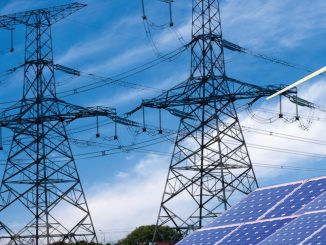The power industry’s focus is shifting from green electricity generation to green energy transition. The aim is not only to expand clean power capacity but also to increase green hydrogen production and set up energy storage projects. In addition, the domestic manufacturing of solar modules has become a priority for policymakers. While navigating this transition, industry stakeholders are facing challenges related to land acquisition, power evacuation, recurrent policy and regulatory changes, etc. At the India Energy Transition Summit 2022 organised by the Federation of Indian Chambers of Commerce and Industry, leading industry experts discussed these challenges and provided policy suggestions. Edited excerpts…

Vivek Bhide
For clean energy transition, the uptake of green hydrogen is extremely important. There are a few challenges in the manufacturing of green hydrogen in the Indian context. We need land, water supply for electrolysers and 24×7 supply of renewable energy to the manufacturing units. There are issues pertaining to costs as well. If we break up the cost of green hydrogen, there is a stack-related component in electrolysers that would be 22-25 per cent of the overall cost. Also, there is a huge cost associated with balance of plant and power electronics that can be mitigated by promoting local manufacturing. There are issues of transportation and energy storage as well since hydrogen is a highly inflammatory gas.
For accelerating green hydrogen manufacturing in India, I would like to make five key recommendations. One, India has an immense pool of talent and technology. Thus, investing heavily in green hydrogen research and development will harness the innovative potential for India’s green energy transition. Two, there is a need for more production-linked incentive (PLI) schemes for electrolysers and related green hydrogen facilities in India. Three, there should be import duty concessions for importing global metals as far as electrolyser manufacturing is concerned. Four, to enable low-cost financing, we need to attract foreign direct investment to help accelerate green hydrogen manufacturing. Five, we should introduce hydrogen purchase obligations and create markets to balance the demand and supply.

Hitendra Dave
The solution for financing energy transition commences with fixing the underlying basic issues. A banker is concerned about land acquisition-related issues and regular changes in policies and regulations during the project’s construction period. The higher the risk of developing a project, the lower will be the possibility of getting a long-tenor bank capital. The banking system is willing to lend capital but on assurances that there are visible cash flows or a demonstration of sale of goods that will be converted into money later.
A key concern is that not all contracts are adhered to or honoured, resulting in long judicial processes. Hence, it is important to fix basic issues like associated project risks in the infrastructure sector. Most infrastructure sector projects face high risk in land acquisition, allocation of state government funds, maintenance of law and order and many more. Thus, the industry needs to give confidence to the lenders with a clearer visibility of cash flows.
Given that some projects have extremely long tenures for completion, the country needs to establish an institution that can provide partial credit guarantees. Such institutions should be set up as specialised institutions to provide first loss guarantee for projects.
There must be institutions undertaking currency risks to manage the associated hedging risks. It is time for India to consider a proper export credit agency wherein some subsidised funding is available for longer tenors. Eventually, for larger infrastructure for green energy transition, there is need for an Employees’ Provident Fund Organisation, pension funds and insurance companies to direct equity risk where project risks are taken up by long-term savers. According to me, debt has been underpriced and going forward we need to prepare for more realistic bidding.

Somesh Kumar
Battery storage is an emerging domain of focus in India’s energy transition. However, high costs are turning out to be the biggest roadblock in the segment. Currently, the cost is on the upward side at Rs 10 per kWh. The government aims to bring down the round-the-clock costs to Rs 6-Rs 7 per kWh over a period. The key question is how to bring the costs down to the desired level in the coming years. The government has already adopted certain interventions in this regard. For instance, the PLI scheme has been introduced to offset costs and provide incentives for battery production; a viability gap funding mechanism has been adopted; and concessional financing has been offered. However, these are temporary interventions, which are likely to be unsustainable in the long run. Concessional financing, for instance, cannot be sustained over a long period of time as eventually, financing must be sustainable for both lenders and borrowers. Therefore, mechanisms that are self-sufficient and economically viable in the long run must be adopted as has been done in India’s solar power sector.
One effective way to bring down the cost of battery storage in the long run is to increase the scale of production. Thus, if greater certainty about the scale of battery storage projects can be provided in the coming years, one can expect a greater thrust from the industry stakeholders to innovate and further bring down the costs. Moreover, we are still largely dependent on imports for battery components as the supply chain is limited in the country. This is a huge limiting factor. Several countries have vertically integrated their supply chain, but India has not done that so far. Therefore, India must move towards integrating its supply chain vertically, making battery storage more cost effective, especially given the rising challenges of global energy security. Further, since India does not possess abundant domestic natural reserves for battery materials, a robust battery recycling policy is important. The materials we procure and recycle could bring down the costs as well. This process would be more sustainable. Finally, giving greater importance to research and development and innovation in battery storage would go a long way in achieving the desired outcomes. New materials that bring down the cost can also be explored. Indeed, the cost will come down, but how fast that would happen is a crucial question.
Ultimately, as we proceed in our mission of clean energy transition, it is important to ensure that this is a just transition. The concept of just transition is vital and must be considered in all aspects of decision-making pertaining to clean energy development. As we move towards cleaner fuels, we must also focus on its impact on the environment, employment, social security and livelihoods. Several studies have found that energy storage has the potential to increase electricity tariffs in the current term, so it is important to consider whether India can afford such a rise in tariffs. Research by EY has also found that more than 110,000 jobs can be affected due to the closure of coal mines. The renewable energy industry could enable significant job creation, but whether it will provide jobs to people who are losing their jobs is uncertain. The transition will be just if such a disadvantage is not created. Our clean energy transition would, thus, go hand in hand with the upskilling and reskilling of the workforce. Going forward, an institutional mechanism with a transition fund can also be set up, particularly for states where the population is likely to be severely impacted.

Kishor Nair
Many companies are interested in investing in the renewables sector, but there are many challenges for project developers. The most critical challenges pertain to land acquisition and transmission infrastructure. These are the two key aspects that are holding us back from setting up our capacity. The country has a non-fossil fuel capacity target of 500 GW by 2030. Of this, it has already installed 150 GW. The balance 350 GW will require around 1.4 million acres of land. Since we require contiguous land for a solar project, we are facing a lot of trouble finding even 500 acres of land at a single location.
We have recently commissioned the world’s largest solar project of 1,250 MW at a single location in Bikaner, which required 5,000 acres of land. A key issue that should be highlighted is that approximately 90 per cent of the land in India is categorised as agricultural land, necessitating its conversion for industrial use. The core issue in many states is that the land is already classified as Class 1 or Class 2, which means that before utilising it for solar projects, one must change its classification to the suitable Class 4. We also encounter land that is allocated to Scheduled Castes and Scheduled Tribes, which cannot be used for industrial purposes.
In some states, prior permission is required for the acquisition of land. Even in big states like Uttar Pradesh, clearance is needed in advance to purchase land for industrial purposes. To top it, we have issues when the land is barren but it still costs a lot. This is because when planning to buy land to set up a project, local politicians will induce villagers by saying that they will receive any amount of money that they request. The land is purchased at the asking price set by the landowner. They no longer have any claim to the land after that. Today, however, we find ourselves in a predicament where after paying the whole price and buying the land, we continue to face land acquisition issues. Government policies and support are required to solve these issues.
A lot of time and energy will be saved if the agricultural and renewable energy sectors are regarded as green industries and this will eliminate half the problems. Further, all of the states’ available barren land can be put to use for solar or other renewable energy projects. It will save a lot of time if the states can identify the land on which project development is accepted with all the necessary approvals. The distribution and transmission companies can set up energy evacuation and energy storage infrastructure on those locations.

Gautam Reddy
In order for energy transition to be successful, multiple solutions are required at present, as one single solution would not address every issue. Pumped storage, from India’s perspective, is an outstanding solution. If the same thing is attempted in Europe or the US, the scale and cost arbitrage may not make such projects feasible. However, India can deliver energy storage through pumped storage projects at a much lower cost than any other technology in the next decade. New technologies will surely come, like they should, as the country needs to develop sufficient storage capacity for deep decarbonisation, and it is quite encouraging that the government is promoting energy storage.
To give a little more perspective on deep decarbonisation, 80 GW out of roughly 210 GW of peak power consumption in India is by industrial consumers. Most of this can be attributed to captive coal industries, including large steel, aluminium and other facilities, which are some of the most intense emitters of carbon. It is important to tackle carbon emissions from these industries to seriously move towards deep decarbonisation. However, these are very cost-conscious industries. They eventually need a solution where captive coke can be replaced with a continuous green power source that is also cost effective. A pumped storage system is very beneficial in the Indian context and can be more useful for industries than even power utilities.
There are surely plenty of challenges in the adoption of pumped storage facilities, but they are being addressed. As with any other big infrastructure project, land availability and acquisition continue to be a big issue in pumped storage projects as well. We are building four pumped storage projects at present with the first one expected to be commissioned by the end of next year and our other projects in Madhya Pradesh and Karnataka have also received permits. The typical size of land required for just the storage part is 1,500 acres. Along with this, solar and wind power plants need to be set up, which require 15,000-20,000 acres of land for just 3-4 GW of project capacity. On the transmission side, the government has introduced enabling policies and power can be wheeled in and out without any transmission charges.
Land-related issues need to be tackled like the road development work, where the government identifies the prospective sites and takes care of the bulk of the acquisition. Then, this land can be allocated to a project developer. This will significantly help in addressing land acquisition issues especially in forest areas.
Other areas that require policy direction are related to recognising revenue streams from the host of ancillary services that pumped storage projects provide apart from storage like grid balancing and frequency regulation. Even standalone energy storage has no defined revenue stream at present. However, efforts are being made in these areas, which would help promote investments in the future.

Saibaba Vutukuri
It is interesting that the industry has shifted its focus from green electricity to a broader aim of green energy transition. With this, the focus has also shifted to the promotion of green hydrogen, which will require additional capacity of renewables and therefore additional capacity of solar modules. For 2030, the solar capacity target is 280 GW. To meet this target alone in the next eight years at least 20-25 GW of solar modules need to be deployed. In addition, solar modules will be needed to meet the ambitious green hydrogen production plans, which rely heavily on solar power given it is the cheapest source of electricity.
The key issue is that historically 90 per cent of the solar modules have been imported, mostly from China. We have to understand that there is a cost to the country as solar projects are being set up with imported solar modules. India’s energy import bill is only expected to increase significantly in the coming years; this needs to change. Just to meet the 2030 solar targets, the country will need to spend approximately $50 billion on imports. We need to create jobs in the country by promoting domestic manufacturing, attract the most efficient technology and become self-sufficient. In the initial phases, China was giving a tremendous amount of benefits to promote the domestic manufacturing ecosystem and with economies of scale it has become extremely cost competitive.
Unfortunately, India missed the domestic manufacturing bus, as for a long time government policies have not been favourable. In India’s automotive industry, a similar trend existed 30-40 years back when the reliance on imports was heavy. With tariff and non-tariff barriers over a period of 20-25 years, the domestic industry was built. Now the industry is globally competitive and is exporting to the world. At least the current government is trying to promote domestic manufacturing with tariff- and non-tariff-based barriers. The positive policy initiatives have been the PLI scheme and basic customs duties on solar modules and cells. On the back of these initiatives, big industry players have announced ambitious plans in this space and we have also doubled our production capacity in the past one year and plan to increase it by three times in the next three to four years.
It should be noted that the PLI scheme only attracted three to four players. However, going forward, around 20-30 manufacturers are needed to meet the capacity needs. For the next phases of the PLI scheme, an outlay of Rs 195 billion has been announced, which is a positive development as compared to the first phases when approximately 50 GW of applications were received but the majority remained in the waiting list. The plan now is to come up with a new PLI bid, however, that is not required and the waitlisted players from the first phase should be cleared first.



